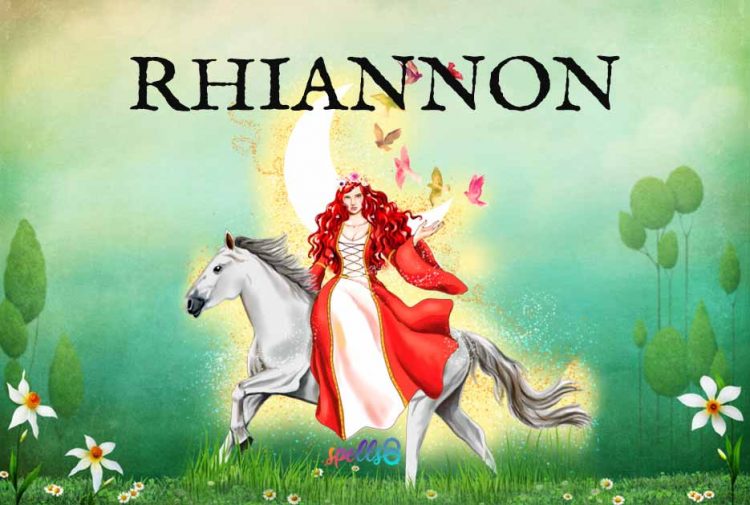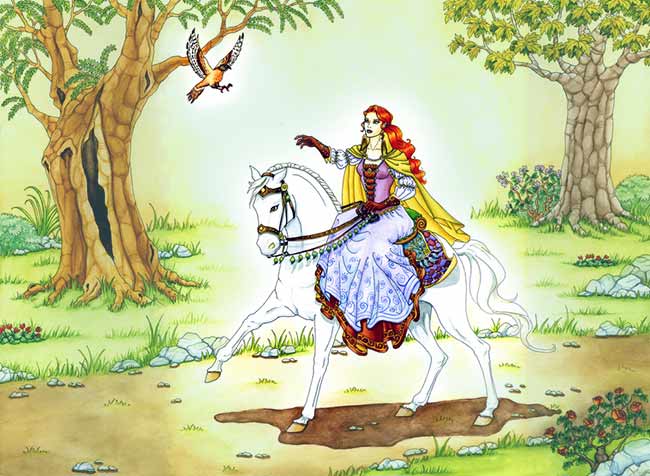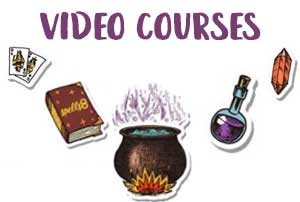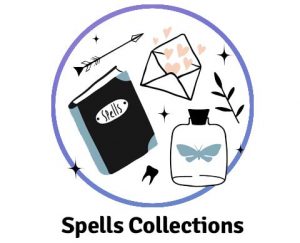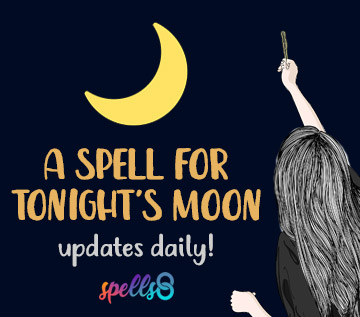Rhiannon is a beautiful woman from the Welsh Otherworld, often seen riding a white horse. Her name is pronounced REE an-on and she appears in the mediaeval Welsh tales The Mabinogi of Pwyll Prince of Dyfed and The Mabinogi of Manawydan ap Llyr.
While some academics like Proinsias Mac Cana claimed that Rhiannon is a goddess, the stories in the Mabinogion imply that she is an otherworldly being but not a goddess. However, it is assumed that her legend was inspired by an earlier horse goddess known as Epona. She uses some magic, though it is unclear where the source of her power derives from.
Rhiannon, Celtic Goddess?
Like many other Celtic gods and goddesses, Rhiannon is depicted as human, a common conception found on early medieval Celtic literature, when Christian scribes may have felt uncomfortable writing about the powers of pagan gods. Modern practitioners (of Wicca and other Neopagan traditions) may choose to work with Rhiannon as a goddess or as an incarnation of the Divine Feminine.
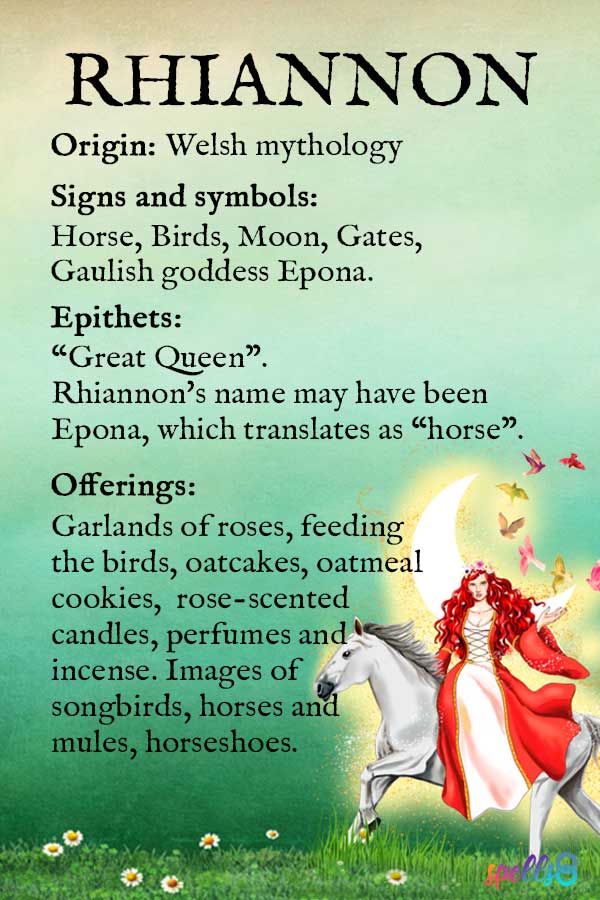
The best way to connect with Rhiannon, like any deity, is through her mythology, epithets and symbols. Scroll down to find offering and ritual ideas, and the most important tales featuring the goddess Rhiannon, and how to worship Her in your personal pagan (or Wiccan) practice.
- Myth of Rhiannon
- Tale of Rhiannon and Pryderi
- Symbols of Rhiannon
- Titles and Epithets of Rhiannon
- How to Worship Rhiannon as a Goddess
- Further reading
Rhiannon Mythology
This tale is one of a group found in The Mabinogion, one of the earliest known efforts to form a collection of traditional Welsh tales:
One day, Prince Pwyll was feasting at his palace of Narberth, entertaining a large host of his men. After eating his first meal, he went to the top of the nearby mound of Gorsedd Arberth.
“My Lord,” a member of the court said, “whoever sits upon the mound cannot leave without either suffering injury or seeing a wonderous sight.”
Pwyll scoffed. “I fear no injury, not with an army of men as large as this at my back. Wonder, though, I’d gladly see wonder. I shall sit upon the mound.”
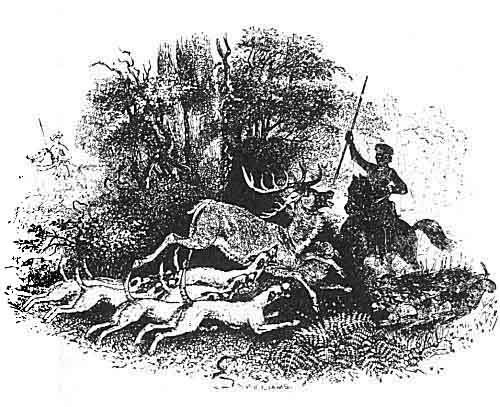
And so he did. Pwyll plopped down on the mound, determined to see a sight of wonder. As he sat, he caught glimpse of a woman, no, not a woman, a lady, riding a magnificent white horse. The horse loped at an easy pace and appeared to be venturing up the mound. Awestruck, Pwyll turned to his men.
“Men,” he whispered, “who among you knows yon lady?” The men murmured among themselves and it soon came out that none of them knew who the lady was. “One of you go and greet the lady. I wish to know her name.”
So one of Prince Pwyll’s men rose and went forth. The prince’s man came up the road to greet the lady, though he had trouble keeping up as he was on foot and she astride the horse. The prince’s man hastened his pace, and yet the quicker her followed her, the further away from him she went. Frustrated, the prince’s man returned to Pwyll.
“My lord,” he said. “It is futile to follow her on foot.”
“Indeed,” Pwyll responded, “Get you to the palace and fetch the fastest horse from the stables, then follow her.”
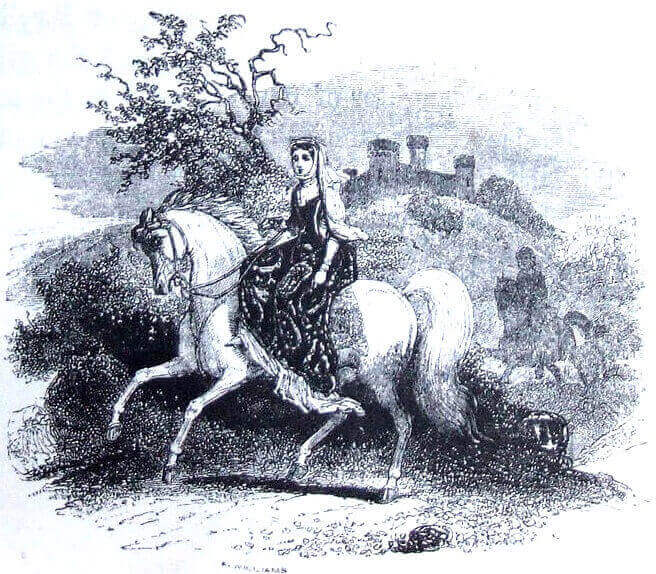
The prince’s man did so, grabbing the reins of the fastest horse in the stables. He reached an open plain and, upon seeing the lady again, spurred the horse onward. However, the faster his horse went, the further away the lady was. Flabbergasted, the prince’s man returned to Prince Pwyll.
“My lord,” he said, “it will do no good to follow the lady. There’s no faster horse in the realm than the one between my legs, and yet I still cannot reach her.”
“There must be some illusion at work,” Pwyll said, scratching his chin. “Let us return to Palace Narberth.”
The next day they repeated the routine, from feasting to following the lady, yet the attempt failed once again, even though Pwyll had a different man attempt to reach the lady. So, they returned to feast and sing in the palace the entire night.
The next day, Pwyll determined to do the routine again, this time himself. He had a page saddle him up and bring him his spurs. Again, they went up the mound, again they saw the lady passing by. Pwyll mounted his horse and bounded after her, though the second and third steps brought him no closer to her than the first.
“Lady!” Pwyll called, fearing that she would leave his presence, “for the sake of the man that loves you most, please stay for me!”
A smile crossed the lady’s lips.
“Aye,” she said, “I’ll stay for you, and gladly.” She brought her horse to a halt, then threw back the headdress that covered her face. Her eyes settled on him.
“Where do you come from?” Pwyll asked. “Where are you heading?”
“An errand,” she said. Pwyll realized that he’d never seen a woman as beautiful as she was. “I came to seek you. My name is Rhiannon, daughter of Heveydd Hen. I was to be wed against my will, but I want no husband save for you.”
“By God,” Pwyll exclaimed, “if I were given choice of all the damsels of the world, I’d choose you.”
They came to an accord, swearing to meet one another in twelve months at a place of Rhiannon’s choosing. She chose the Palace Heveydd, and Pwyll agreed to meet her there in a year so that they could be wed.
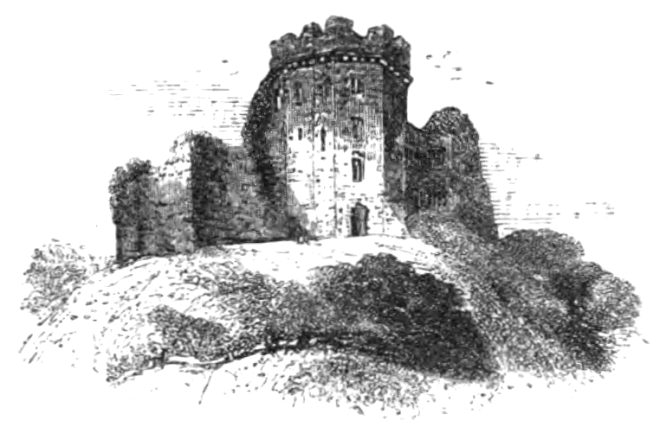
The time came and Pwyll ventured to the Palace of Heveydd with a host of men. They were greeted by the palace, and much feasting and rejoicing commenced as the palace readied for the marriage. Heveydd Hen sat to one side of Pwyll, and Rhiannon sat on his other side.
During the ceremony, a tall youth with auburn hair entered, distraught. The youth was Gwawl ap Clud. Pwyll, seeing that Gwawl was upset, promised whatever he could to ease Gwawl’s state of mind. Gwawl then tricked Pwyll, asking for Rhiannon’s hand.
It was revealed that Gwawl was the fiancée that Rhiannon did not wish to marry. Pwyll could not break his promise and remorsefully he gave Rhiannon over to Gwawl. As Pwyll and Rhiannon had not yet wed, he could not refuse. Another date was set, a year from then, for the marriage of Gwawl and Rhiannon.
Rhiannon cooked up a scheme to help Pwyll win her back from Gwawl’s clutches. Pwyll returned to the palace after a year, this time dressed in shoddy clothes and carrying a magical sack that Rhiannon had given him. Spying Gwawl, he greeted his rival.
“I have a favor to ask of you, Gwawl” Pwyll said, loosening the strings on the bag.
“Speak, man,” Gwawl responded.
“I simply wish to fill this bag with meat.”
So Gwawl ordered his servants to fill Pwyll’s bag with meat, but however much food they put into the bag, it never filled up. Perplexed, Gwawl asked whether or not the bag would ever fill.
“No,” Pwyll said, “not unless a man possessing lands and titles were to push the meat down in the bag with his feet and say, ‘Enough has been put therein’.”
Rhiannon urged her fiancée to do this for Pwyll, and Gwawl agreed to. Gwawl put his two feet in the bag and began to say the words.
“Enough has been—” But as soon as these words escaped Gwawl’s lips, Pwyll upended the bag and trapped Gwawl inside, tying the strings shut tight. Pwyll threw off his disguise and his men captured Gwawl’s own, throwing them into the palace’s prison. When asked what was inside the bag, Pwyll responded that it was a badger. Men began to beat the bag until Gwawl relinquished Rhiannon to Pwyll, whereupon they married and she became his queen.
Tale of Rhiannon and Pryderi
Another tale involved Rhiannon after she gave birth to her and Pwyll’s son. The newborn went missing after he was born, as Rhiannon’s six maids fell asleep and did not keep an eye on the child. Fearing punishment, the maids slaughtered a dog and smeared the sleeping Rhiannon with its blood. They accused Rhiannon of eating her own child. Horrified, Rhiannon offered to undergo penance. She sat by the castle gates and told travelers of her tale, offering to carry them on her back.
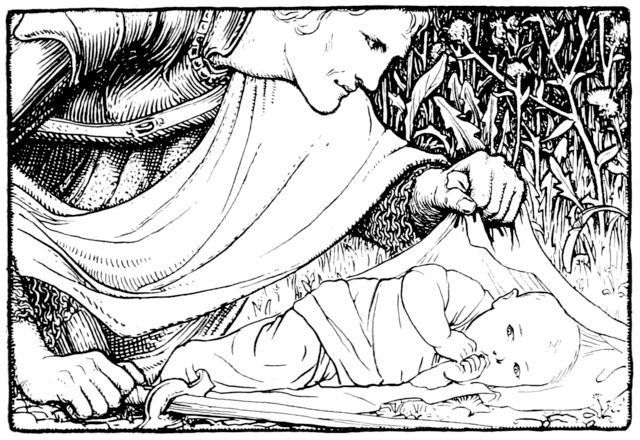
The missing child was discovered by the horse lord Teyrnon. This happened when a monstrous claw burst through Teyrnon’s window and snatched a newborn colt by the mane. Teyrnon slashed the claw with his sword, then rushed outside to catch sight of the creature that was stealing his horses. He chased the sound of cries into the night before recalling that he left the door to his house open. When he returned, he noticed that there was an infant boy inside. Astonished, he informed his wife of the child. The child displayed supernatural strength despite his small size.
As time passed, Teyrnon also heard of the tale of Rhiannon, as she had to tell it to many travelers. Eventually Teyrnon puzzled out that the boy resembled Pwyll and returned the child to Rhiannon and Pwyll, restoring the child to his family and also restoring Rhiannon’s honor. Elated, Rhiannon named the child Pryderi, and he would succeed his father after his death as a great hero.
Symbols of Rhiannon
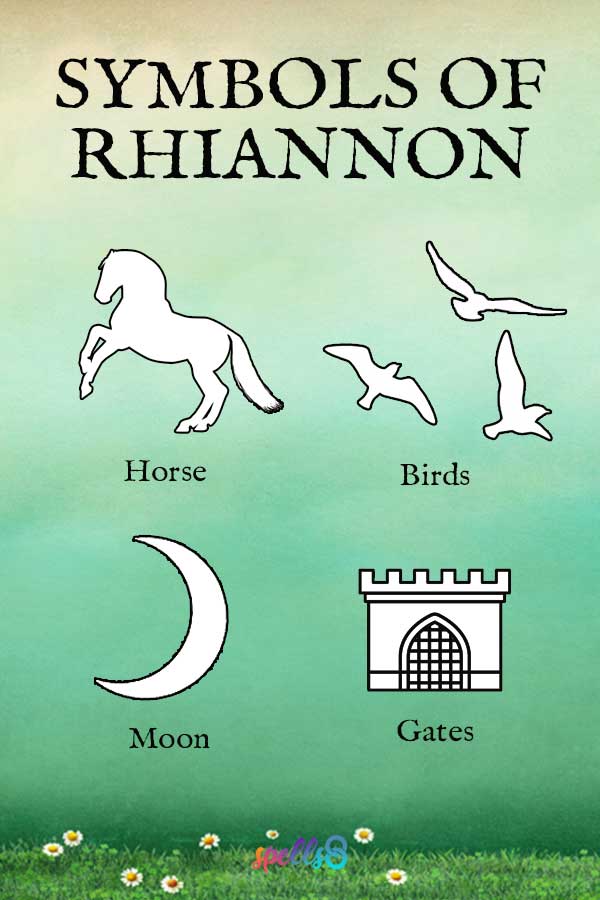
Horse
In Rhiannon’s story, horses play an important role. Rhiannon first captures the attention of her future husband while upon horseback. The horse also symbolizes the ability to move at will between worlds. Rhiannon rides her white horse within the sacred service of guiding newly transitioned souls back to the Light, ensuring safe passage back to Spirit.
Birds
Also aligned with the Winged Ones, Rhiannon is known to have magical birds that sing beautiful songs of enchantment. The songs of her birds are believed to be able to bring restorative, peaceful slumber, singing so sweetly that the dead awaken and the living fall into a trance. Birds bring the energy of Transcendence and as animals of the Earth and of the Sky, these feathered friends help us to bridge the energy of Heaven and Earth.
Moon
Rhiannon is often associated with the Moon, mainly because in the Welsh tales, she was born at the first moonrise. Her white horse is also a reminder of lunar energy and light. In modern paganism, the lunar symbology where the three phases of the moon, the waxing phase, the full moon, and the waning moon, refer to the Triple Goddess, representing the Mother, Maiden, and Crone. It symbolizes the cosmic cycle and the eternal processes of life, death, and rebirth.
Gates
In the tale of Rhiannon and Pryderi, Rhiannon is accused of murder and punished for her deeds. She has to sit by the castle gate where she is forced to tell her story to any travelers and to offer to carry them on her back as a beast of burden. The gates can also symbolize the entrance to the Otherworld, the realm of the Celtic deities.
Titles and Epithets of Rhiannon
There are so many parallels between Rhiannon and Epona that most people tend to think of Rhiannon as a later British version of the Gaulish goddess Epona.
Epona Rigani: Epona is the Gaulish horse goddess whose name means simply “horse”. The epithet Rigani means “queen” and it’s linked to Rigantona, thought to have been an earlier Celtic goddess.
Great Queen: Rhiannon’s “real name” may have been Epona; Rhiannon is a title, most often interpreted to mean “Great Queen”.
How to Worship Rhiannon
In modern practice, Rhiannon is a lunar goddess of fertility and rebirth, transformation, wisdom, and magic. A goddess of ethereal beauty, she is well known for granting wishes to those who ask for what they want.
People with a special connection to horses will naturally be drawn to Rhiannon, the horse goddess. Starting a relationship with a horse is the best way to approach and show devotion to Rhiannon. Find offerings to Rhiannon below.
She embodies the cleverness of women in patriarchal systems, such as when she helps Pwyll trick Gwawl by giving him a magical bag. She never breaks the rules in that episode, but she helps bend them to a degree that allow her to pursue her true love. Her magical presence, while more subtle than that of other Welsh women such as Arianrhod or Cerridwen, nevertheless mark her as a manifestation of the Divine Feminine.
She is a being of sovereignty, and her association with horses implies a cultured freedom that was hard won.
Rhiannon’s Day
In the First Branch of the Mabinogi, Rhiannon’s newborn son is found by Teyrnon on May Eve (April 30). This is also one of the major Celtic festivals, which was known in medieval Wales as Cyntefin, “The First of Summer”. This is a time when the veil between this world and the Otherworld is said to be at its thinnest.
This holiday, celebrated by Wiccans and other Neopagans as Beltane, is the perfect time for telling the story of how Rhiannon rode out of the Otherworld to claim the man she loved.
Correspondences & Associations of Arianrhod
- Associations: Moon, horses, wind, gates.
- Animals: Horse, badger, dogs, birds.
- Scents: Sandalwood, neroli, lavender, bergamot.
- Gems: Cat’s eye, crystal, bloodstone, moonstone.
- Colors: Dark green, maroon, silver, brown, gold.
- Genealogy: Wife of Pwyll, Prince of Dyved; Mother of Pryderi.
Rhiannon Offerings
Offerings to Rhiannon: Garlands of roses, feeding the birds, oatcakes, oatmeal cookies, rose-scented candles, perfumes and incense. Images of songbirds, horses and mules, horseshoes.
An old folk custom from western Ireland says that if you light fires just before dawn at each corner of a perfectly oriented crossroad (one that runs directly east, west and north, south), then sit down quietly at its side, you can see Epona ride by, flying west from the approaching sunrise.
Further Reading
- Davies, Sioned (trans.) 2007: The Mabinogion
- Jhenah Telyndru. 2018: Pagan Portals – Rhiannon
- Carl McColman. 2020: The Spirit of the Celtic Gods and Goddesses
- William Skene. 2015: The Four Books of Ancient Wales

